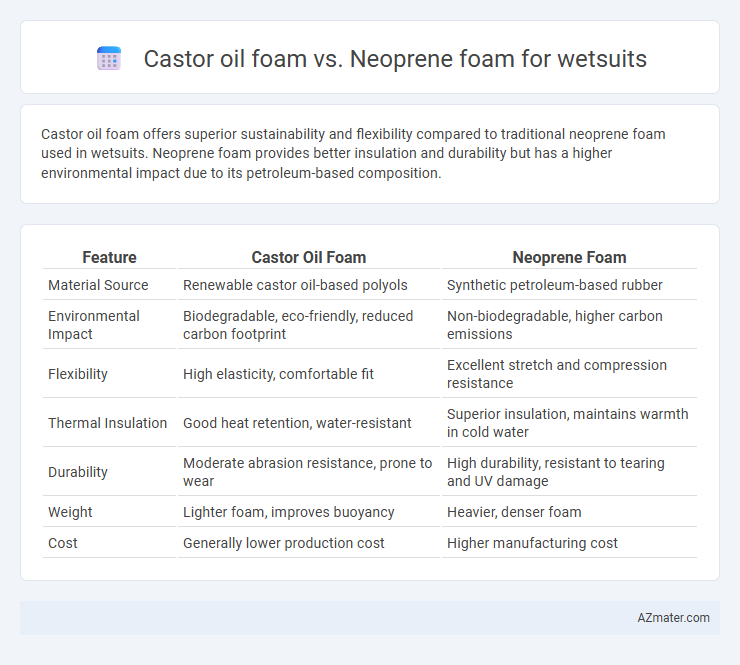Castor oil foam offers superior sustainability and flexibility compared to traditional neoprene foam used in wetsuits. Neoprene foam provides better insulation and durability but has a higher environmental impact due to its petroleum-based composition.
Table of Comparison
| Feature | Castor Oil Foam | Neoprene Foam |
|---|---|---|
| Material Source | Renewable castor oil-based polyols | Synthetic petroleum-based rubber |
| Environmental Impact | Biodegradable, eco-friendly, reduced carbon footprint | Non-biodegradable, higher carbon emissions |
| Flexibility | High elasticity, comfortable fit | Excellent stretch and compression resistance |
| Thermal Insulation | Good heat retention, water-resistant | Superior insulation, maintains warmth in cold water |
| Durability | Moderate abrasion resistance, prone to wear | High durability, resistant to tearing and UV damage |
| Weight | Lighter foam, improves buoyancy | Heavier, denser foam |
| Cost | Generally lower production cost | Higher manufacturing cost |
Introduction to Wetsuit Material Technologies
Wetsuit material technologies primarily utilize Castor oil foam and Neoprene foam, each offering unique benefits in thermal insulation and environmental impact. Castor oil foam, derived from renewable plant-based resources, provides eco-friendly flexibility and durability, appealing to environmentally conscious surfers. Neoprene foam, a synthetic rubber known for superior elasticity and waterproofing, remains the industry standard for high-performance wetsuits due to its exceptional thermal protection in cold water conditions.
Overview of Castor Oil Foam
Castor oil foam, derived from renewable castor beans, offers enhanced sustainability and elasticity compared to traditional neoprene foam used in wetsuits. This bio-based foam provides excellent thermal insulation, buoyancy, and flexibility, making it a popular eco-friendly alternative in water sports apparel. Its natural origin reduces environmental impact while maintaining durability and comfort for extended wear in aquatic activities.
Overview of Neoprene Foam
Neoprene foam is a synthetic rubber material extensively used in wetsuit manufacturing due to its excellent insulation properties and water resistance. It provides superior flexibility, durability, and buoyancy, making it ideal for prolonged aquatic activities in various water temperatures. Unlike Castor oil foam, neoprene maintains consistent performance under compression and exposure to saltwater, ensuring reliable thermal protection.
Environmental Impact Comparison
Castor oil foam is a bio-based alternative derived from renewable castor beans, significantly reducing reliance on fossil fuels compared to traditional neoprene, which is petroleum-based and generates higher greenhouse gas emissions during production. The biodegradability and lower toxicity of castor oil foam contribute to a smaller ecological footprint, while neoprene's chemical manufacturing process involves harmful substances that can persist in the environment. Choosing castor oil foam for wetsuits supports sustainable material innovation and decreases the long-term environmental damage associated with neoprene foam disposal.
Flexibility and Comfort Differences
Castor oil foam offers enhanced flexibility due to its natural elasticity and softer texture, providing superior comfort during extended wetsuit use. Neoprene foam, while durable and water-resistant, tends to be stiffer, which can limit range of motion and reduce overall comfort. The bio-based composition of castor oil foam also promotes better breathability and reduced skin irritation compared to synthetic neoprene.
Warmth and Insulation Performance
Castor oil foam offers superior warmth and insulation performance in wetsuits due to its natural oil-based composition, which provides better thermal retention and moisture resistance compared to traditional neoprene foam. Neoprene foam, though widely used, tends to lose insulation efficiency when compressed underwater, whereas castor oil foam maintains flexibility and insulating properties even in colder conditions. This enhanced thermal performance makes castor oil foam wetsuits ideal for extended exposure in cold water environments.
Durability and Longevity
Castor oil foam offers enhanced durability and environmental benefits due to its bio-based composition, providing resistances to UV degradation and saltwater exposure that extend wetsuit lifespan. Neoprene foam is known for its robust durability and excellent resistance to abrasion and compression, maintaining flexibility and insulation over time in harsh marine conditions. While neoprene remains the industry standard for long-lasting wetsuits, castor oil foam innovations are advancing, offering competitive longevity with added sustainability advantages.
Skin Sensitivity and Allergy Considerations
Castor oil foam wetsuits offer a natural alternative with reduced chemical additives, potentially lowering the risk of skin irritation and allergic reactions compared to neoprene foam. Neoprene foam contains synthetic rubber and can release chloroprene, which some individuals may find irritating or allergenic upon prolonged skin contact. For sensitive skin or allergy-prone users, castor oil-based foams are often recommended due to their hypoallergenic properties and biodegradability, promoting comfort and skin health during water activities.
Cost and Market Availability
Castor oil foam wetsuits, derived from renewable resources, often come at a higher price point due to limited production scale and specialized manufacturing processes compared to more widely available neoprene foam wetsuits. Neoprene foam remains the industry standard, benefiting from mass production, extensive market presence, and lower costs, making it more accessible to a broad range of consumers. Availability of castor oil foam wetsuits is currently restricted to niche eco-friendly brands, while neoprene foam dominates global wetsuit markets with diverse options and competitive pricing.
Choosing the Right Foam for Your Wetsuit
Choosing the right foam for your wetsuit depends on durability, flexibility, and environmental impact; castor oil foam offers superior eco-friendliness and enhanced stretch due to its renewable bio-based composition, making it ideal for sustainable wetsuit options. Neoprene foam, a synthetic rubber, provides excellent insulation and durability but has higher environmental costs and less flexibility compared to castor oil-derived alternatives. For eco-conscious surfers seeking performance without compromising warmth and mobility, castor oil foam wetsuits are becoming the preferred choice over traditional neoprene.

Infographic: Castor oil foam vs Neoprene foam for Wetsuit
 azmater.com
azmater.com